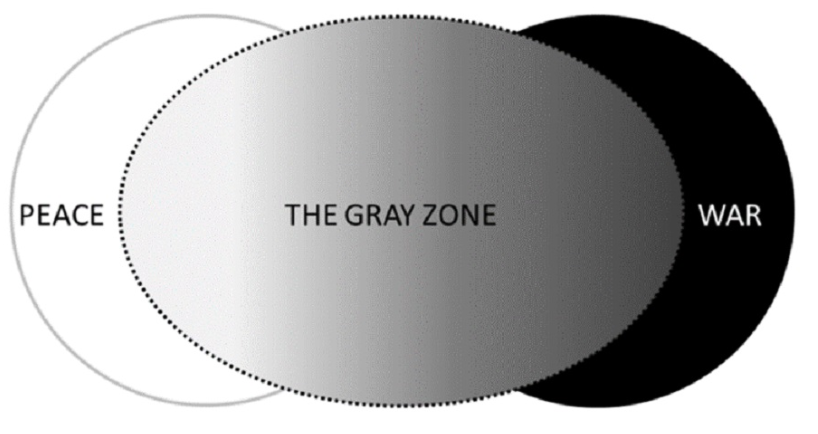Description

Disclaimer: Copyright infringement not intended.
Context
In the lexicon on warfare, “grey-zone” is the latest entry, because of what has happened in the South China Sea and what has happened along our northern borders, Chief of Defence Staff Gen. Anil Chauhan said in a reference to China.
Details
Grey Zone Warfare
- It has emerged as a battlefield-centric concept and is defined as the use of coercive measures to exploit the operational space between peace and war, that deliberately stay below a threshold so as not to prompt a conventional military response to alter the status quo which otherwise would have been attracted.
- In grey-zone warfare the dividend of the action is available only after a long time. The origin of this lies in a historical dispute that the aggressor nation justifies with their modern revisionist claims.
Ambiguity:
- Grey-zone tactics often involve actions that are ambiguous or deniable, making it difficult for targeted nations to respond effectively or attribute responsibility. This ambiguity allows aggressors to exploit legal and political loopholes to achieve their goals while avoiding direct confrontation.
Non-Military Means:
- Grey-zone warfare relies heavily on non-military means such as disinformation, cyberattacks, economic coercion, proxy forces, and political subversion. These tactics are designed to undermine the stability and resilience of target countries without triggering a conventional military response.

Hybrid Tactics:
- Grey-zone operations frequently involve a combination of conventional and unconventional tactics, blurring the lines between military and non-military actions. This hybrid approach allows aggressors to exploit vulnerabilities across multiple domains, including political, economic, social, and informational spheres.
Strategic Objectives:
- The primary objectives of Grey-zone warfare typically include expanding influence, undermining adversaries, weakening alliances, shaping perceptions, and achieving geopolitical advantage.
- By operating below the threshold of conventional conflict, aggressors seek to achieve their goals while minimizing the risk of escalation and retaliation.
Challenges for Defense:
- Grey-zone warfare poses significant challenges for targeted nations, as traditional defense mechanisms may be ill-suited to counter these unconventional tactics.
- Effective response strategies require a comprehensive approach that integrates diplomatic, economic, military, and informational tools to deter aggression, enhance resilience, and mitigate vulnerabilities.
Global Significance:
- Grey-zone warfare is increasingly prevalent in today's geopolitical landscape, with state and non-state actors alike leveraging asymmetric tactics to advance their interests.
- This form of conflict has been observed in various regions, including Eastern Europe, the Middle East, Asia-Pacific, and cyberspace, highlighting its global significance and implications for international security.
China's grey zone warfare against India
- Cyber Operations: The Indian government reported multiple cyber-attacks targeting its power transmission systems in 2022.
- Information Warfare: Intelligence services identified threatening messages to North Eastern Indian communities in Bengaluru as originating from China, part of a broader campaign to influence internal Indian matters.
- Economic Coercion: China’s Belt and Road Initiative and leverage that could be used for political and strategic gains.
- China’s strategy includes funding research and influencing department heads at prestigious universities in the West, aiming to sway academic and policy discourse in fields of strategic interest to China.

India’s Counter Measures To Grey-Zone Warfare
- India has deployed advanced surveillance systems along its borders, including UAVs (Unmanned Aerial Vehicles) and high-tech surveillance cameras, to monitor and respond to any adversarial movements.
- Strategic Partnerships: India and the United States have significantly deepened their defence ties through agreements like the Logistics Exchange Memorandum of Agreement (LEMOA), the Communications Compatibility and Security Agreement (COMCASA), and the Basic Exchange and Cooperation Agreement (BECA). These agreements enhance logistical support, secure communication, and exchange of geospatial intelligence between the two militaries.
- Initially a bilateral naval exercise between India and the US, it now includes Japan and Australia, reflecting the strategic convergence of the Quad countries. Malabar focuses on enhancing interoperability and understanding between the navies.
- Active participation in the Quad, alongside the U.S., Australia, and Japan, to address regional security challenges.
|
PRACTICE QUESTION
"Discuss the ethical implications of gray warfare in modern conflict."
|
















